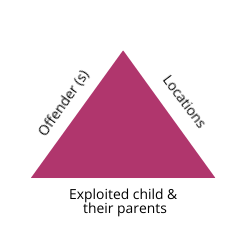
Having spent a lot of time traversing the railways and motorways of Britain training professionals how to improve outcomes for children and families affected by child exploitation I was excited by an invitation to present in Europe. I am contributing to a book by an American writer/survivor and anti-exploitation /trafficking campaigner Dr Katariina Rosenblatt. As part of this book-writing process, I was asked to speak about the work of Pace and the contextual safeguarding approach at an International conference in Prague. You may be pleased to know that Pace’s relational safeguarding model has gone global and the work of Pace was received with a great deal of interest.
My part of the book explores grooming; victim blaming; contextual safeguarding and the work of Pace. It is of note, that contextual safeguarding has global interest because, like the UK, most countries in the global North, have child protection systems set up solely to respond to harm and abuse inside the home (intra-familial). Therefore, many safeguarding professionals and parents across the world are keen to see contextual safeguarding implemented in their child protection systems.
There were delegates from all over the world, involved specifically in aviation security – not my area of expertise! However, it turned out that while their remit is to safeguard the contexts of our airports and skies, this aligned perfectly with the contextual safeguarding approach that Pace advocates – wherein we aim to safeguard young people and contexts outside the home, where young people are at risk of exploitation. The contextual safeguarding approach really resonated with the delegates. The conference was very concerned about the issue of trafficking and how to protect and identify victims and perpetrators of trafficking and exploitation who use their airlines and airports. As it turns out, they are already doing contextual safeguarding.
 In my presentation, entitled: The Contextual Safeguarding Approach: Making hotspots cold, I explained what Pace do and how we encourage professionals to work with parents as partners. I asked the delegates to draw the triangle we use in Pace training courses (taken from Eck and Spelman (1987) Problem Analysis Triangle). The triangle places the young person and family at the base, the offenders on the left side, and locations (hotspots) where the exploitation is taking place on the right. What we find is that almost all of the actions that services take are focussed on the base of the triangle as professionals tend to focus overwhelmingly on the child’s behaviour and the parenting. This is not a holistic safeguarding plan; all three sides of the triangle must have actions and people who can enforce them. If we just focus on the base of the triangle it not only places all the responsibility (and blame) with parents and their child, but it does nothing to stop the offenders or intervene in the locations in which they are offending.
In my presentation, entitled: The Contextual Safeguarding Approach: Making hotspots cold, I explained what Pace do and how we encourage professionals to work with parents as partners. I asked the delegates to draw the triangle we use in Pace training courses (taken from Eck and Spelman (1987) Problem Analysis Triangle). The triangle places the young person and family at the base, the offenders on the left side, and locations (hotspots) where the exploitation is taking place on the right. What we find is that almost all of the actions that services take are focussed on the base of the triangle as professionals tend to focus overwhelmingly on the child’s behaviour and the parenting. This is not a holistic safeguarding plan; all three sides of the triangle must have actions and people who can enforce them. If we just focus on the base of the triangle it not only places all the responsibility (and blame) with parents and their child, but it does nothing to stop the offenders or intervene in the locations in which they are offending.
All in all, the conference was fascinating. Delegates and speakers attended from over thirty-five countries, such as Bali, South America, Canada, Singapore, Germany and many more besides. These colleagues analyse the behaviour of people who access their airports, to try and stop offences from happening in order to protect potential and actual victims. Not only around trafficking and exploitation but terrorism too.
Contextual safeguarding has partnership working at its core, and attending this conference gave me, and Pace a chance to extend our reach and work with new partners whose aim is to protect and bring about change.
Primarily, it was a great opportunity to talk about Pace and our founder Irene Ivison, but also to share the experiences of parents supported by Pace.
Dr Sarah Hall
Senior Trainer and Research Coordinator, Pace


